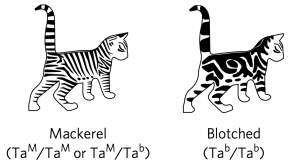The origin of the domestic cat, Felis catus, is radically different from the origin stories of our other domestic animals. All of them are deliberate human creations. Cats appear to have domesticated themselves.
That turned out to be a smart move. As Sarah Zhang observes at the Atlantic: “Domestication has been a fantastically successful evolutionary strategy for cats.”
More evidence for self-domestication: In addition to its genetic similarity to its wildcat forebear, Felis silvestris lybica, Annalee Newitz at Ars Technica tells us, “House cats also show none of the typical signs of animal domestication, such as infantilization of facial features, decreased tooth size, and docility.” No floppy ears or curly tails either.
This cat origin story is courtesy of a big new study of old mitochondrial DNA of cats recovered from archaeological sites in the Near East, Africa, and Europe, according to Laura Geggel at LiveScience. The samples ranged from 100 to 9000 years old. (Mitochondrial DNA is found outside a cell’s nucleus, where most DNA resides. There are hundreds of copies of mtDNA in most cells, and it is passed down to offspring only by mothers, not fathers. So studying mtDNA is studying maternal ancestry only.)
The mtDNA study shows that there seem to be two domestic cat lineages. “The first showed up in southwest Asia and reached Europe as early as 6,400 years ago. The second, originating in Egypt after the southwest Asian line and before 1,000 years ago, spread throughout the Mediterranean world along both land-based and maritime trade routes,” says Gemma Tarlach at Dead Things.
Cats’ self-domestication began when we invented agriculture. Stored grain attracted rodents, and rodents attracted wildcats. Farmers were pleased with that arrangement, and so cats followed early farmers out of the Fertile Crescent and later Egypt. As valued pest-hunters on ships, too, they sailed the world. “The modern domestic cats in Australia are the same as in Europe and as in America,” one of the paper’s authors told Maya Wei-Haas at Smithsonian.
Scientists long thought that cats originated in Egypt–until a 9500 year-old human grave on Cyprus also yielded the body of a pet cat, says David Grimm at Science. It’s not clear whether Egyptian cats, known as Type C, originated as a separate domestication or from imported Near Eastern domestic cats, Type A. However, it’s the Egyptian cat, highly valued there and even regarded as sacred, that has come to dominate the world of pet cats–perhaps, scientists speculate, because it was tamer and more sociable.
The paper was published June 19 in Nature Ecology & Evolution. It was the culmination of an arduous decade-long process involving begging samples from museums. In contrast to remains of other domestic animals in archaeological sites, ancient cat remains are scarce.
But keep in mind that, comprehensive as it was, this was a study of cat mtDNA alone–pretty much a study of a single gene that doesn’t recombine, according to Jerry Coyne at Why Evolution is True. He points out that we need studies of the true cat genome, nuclear DNA with its thousands of genes.
True enough, but getting intact DNA, especially nuclear DNA, from ancient samples is a huge challenge. That’s partly because there’s only one copy of nuclear DNA in each cell. Also, DNA is vulnerable to easy degradation by heat and water. The authors of the new cat study tried for nuclear DNA and failed.
Coyne would also like to know more about ancient DNA from cats in China. He notes that there is some evidence suggesting they might have been domesticated there before 5300 years ago.
Domestic cats have bred periodically with at least two of the other wildcat subspecies. But the first human-created cat may have been the striped and whorled blotched tabby, which appeared after the 13th century in Turkey. Today that blotched coat pattern occurs in 8 out of 10 domestic cats. It’s the result of a mutation in Taqpep, the gene for the cell membrane protein transmembrane aminopeptidase Q.

Cats have lived with us for at least 10,000 years. But, in contrast to our millenia-long genetic tinkering with other animals, we only began developing specific cat breeds in the 19th century.
What is the future of the domestic cat? Newitz argues that we are only at the beginning of serious cat breeding. Thousands of years from now, cat forms may be as various as today’s dogs. She speculates: “Imagine having a golden retriever-sized cat, with the same sunny disposition. Tomorrow’s cat lovers might be living with baby-faced tigers or ultra-fluffy purse cats who look like kittens forever.”


Spread the word